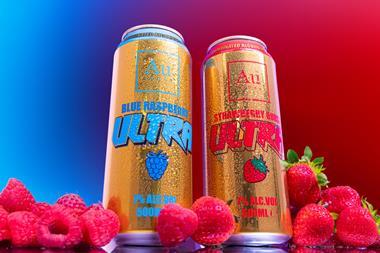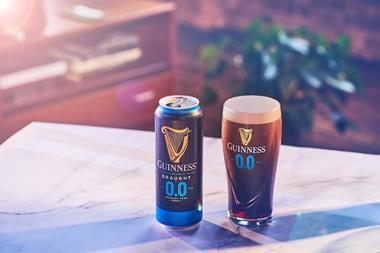Suppliers should work together not fight each other, says Sid Patten, chief executive, SSPO
Birds Eye's new advertisement for its salmon products - which says that farmed salmon are pink because of a "synthetic colorant" - has veered way off course and I am very disappointed that it has chosen to take this cynical approach (The Grocer, April 29, p6). I am also surprised as this comes from a company - Unilever - that was a pioneer in salmon farming and claims to be promoting high nutritional standards.
As the leading trade body representing the salmon farming industry, the Scottish Salmon Producers' Organisation is fully aware that consumer confidence is key to the future development of the salmon market, as it is for the whole food industry.
To ruthlessly cast doubt on the way in which salmon farmers raise their fish, and by implication the nutritional value of farmed salmon, is alarmist and irresponsible.
The fact is that salmon, both wild and farmed, are pink because they consume carotenoid pigments such as astaxanthin.
In the wild, salmon take up this pigment from the likes of shrimp and other organisms. Salmon farmers simply provide the same elements in their feed.
As well as providing the necessary colour, carotenoid pigments are known to be excellent antioxidants and many nutritionists recommend increased consumption of foods containing these types of substances (eg fruit and peppers) because of their beneficial effects.
Plainly, there are benefits to be conferred from including these in the diet of salmon, not to mention the strong fish welfare grounds - assisting the reproductive process and protecting the eggs.
Despite reassurances from Unilever on the day the ad was first broadcast (Monday April 24), the commercial did not mention that astaxanthin is approved for use in the EU for inclusion in diets of salmon.
I fear that disparaging advertising such as this may threaten consumer confidence in all salmon products. And this is at a time when consumption of fresh salmon has never been higher.
According to latest research from TNS Worldpanel, the total annual consumption of fresh salmon peaked at 356 million meals in 2005 compared with 301 million in 2003, an increase of 18%. Contrary to a customary drop, the winter and spring periods have shown strong growth, as have the expected summer and autumn periods, with fresh salmon now being enjoyed all year round. The growth is being driven by a continuing interest from younger people, rather than an increase in frequency of consumption from established consumers. Traditionally eaten by people over the age of 45, new, younger consumers of salmon are growing the quickest, particularly adults aged 17-44 and children. Some 1.4 million new consumers ate fresh salmon for the first time over the course of the last monitored 24 months [TNS data up to November 2005].
It would seem that the 'eat more fish' advice from authoritative bodies such as the FSA and the Joint Health Claims Initiative (JHCI), through to the increasing awareness of long chain Omega-3 and its role in maintaining a healthy heart, has had an extremely beneficial impact on the market. Clearly, it is important that fresh salmon is continuously cited as an essential part of a healthy diet. By attempting to turn people away from eating farmed salmon in favour of its own frozen products, Birds Eye is doing the nation a nutritional disservice.
All salmon suppliers, whether of farmed or wild, should grasp the opportunity to promote the health benefits that fish confers rather than attacking one another.
Consider for a moment the astonishing FSA statistic that, on average, people in the UK eat only a third of a portion of oil-rich fish such as salmon a week. With this in mind, coupled with the current consumer appetite for salmon, there appears to be great potential for further growth without employing such hazardous tactics.
Birds Eye's new advertisement for its salmon products - which says that farmed salmon are pink because of a "synthetic colorant" - has veered way off course and I am very disappointed that it has chosen to take this cynical approach (The Grocer, April 29, p6). I am also surprised as this comes from a company - Unilever - that was a pioneer in salmon farming and claims to be promoting high nutritional standards.
As the leading trade body representing the salmon farming industry, the Scottish Salmon Producers' Organisation is fully aware that consumer confidence is key to the future development of the salmon market, as it is for the whole food industry.
To ruthlessly cast doubt on the way in which salmon farmers raise their fish, and by implication the nutritional value of farmed salmon, is alarmist and irresponsible.
The fact is that salmon, both wild and farmed, are pink because they consume carotenoid pigments such as astaxanthin.
In the wild, salmon take up this pigment from the likes of shrimp and other organisms. Salmon farmers simply provide the same elements in their feed.
As well as providing the necessary colour, carotenoid pigments are known to be excellent antioxidants and many nutritionists recommend increased consumption of foods containing these types of substances (eg fruit and peppers) because of their beneficial effects.
Plainly, there are benefits to be conferred from including these in the diet of salmon, not to mention the strong fish welfare grounds - assisting the reproductive process and protecting the eggs.
Despite reassurances from Unilever on the day the ad was first broadcast (Monday April 24), the commercial did not mention that astaxanthin is approved for use in the EU for inclusion in diets of salmon.
I fear that disparaging advertising such as this may threaten consumer confidence in all salmon products. And this is at a time when consumption of fresh salmon has never been higher.
According to latest research from TNS Worldpanel, the total annual consumption of fresh salmon peaked at 356 million meals in 2005 compared with 301 million in 2003, an increase of 18%. Contrary to a customary drop, the winter and spring periods have shown strong growth, as have the expected summer and autumn periods, with fresh salmon now being enjoyed all year round. The growth is being driven by a continuing interest from younger people, rather than an increase in frequency of consumption from established consumers. Traditionally eaten by people over the age of 45, new, younger consumers of salmon are growing the quickest, particularly adults aged 17-44 and children. Some 1.4 million new consumers ate fresh salmon for the first time over the course of the last monitored 24 months [TNS data up to November 2005].
It would seem that the 'eat more fish' advice from authoritative bodies such as the FSA and the Joint Health Claims Initiative (JHCI), through to the increasing awareness of long chain Omega-3 and its role in maintaining a healthy heart, has had an extremely beneficial impact on the market. Clearly, it is important that fresh salmon is continuously cited as an essential part of a healthy diet. By attempting to turn people away from eating farmed salmon in favour of its own frozen products, Birds Eye is doing the nation a nutritional disservice.
All salmon suppliers, whether of farmed or wild, should grasp the opportunity to promote the health benefits that fish confers rather than attacking one another.
Consider for a moment the astonishing FSA statistic that, on average, people in the UK eat only a third of a portion of oil-rich fish such as salmon a week. With this in mind, coupled with the current consumer appetite for salmon, there appears to be great potential for further growth without employing such hazardous tactics.














No comments yet